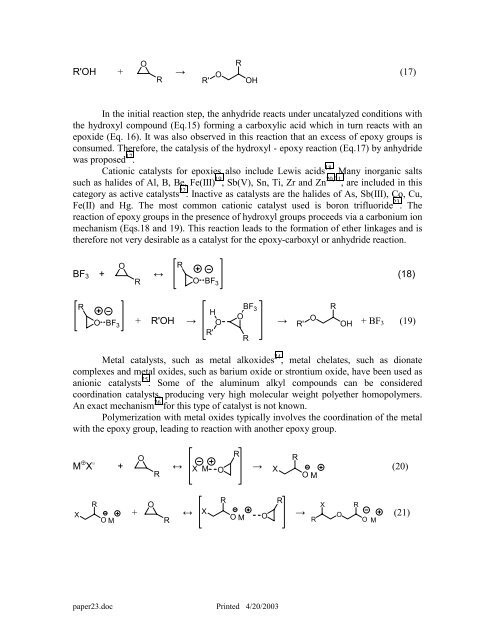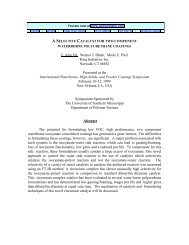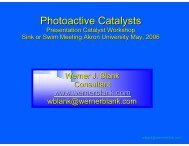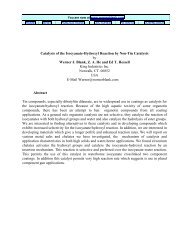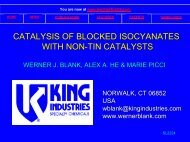Catalysis of the Epoxy-Carboxyl Reaction - Werner Blank
Catalysis of the Epoxy-Carboxyl Reaction - Werner Blank
Catalysis of the Epoxy-Carboxyl Reaction - Werner Blank
Create successful ePaper yourself
Turn your PDF publications into a flip-book with our unique Google optimized e-Paper software.
R'OH +<br />
O<br />
R<br />
→<br />
R' O<br />
OH<br />
paper23.doc Printed 4/20/2003<br />
R<br />
In <strong>the</strong> initial reaction step, <strong>the</strong> anhydride reacts under uncatalyzed conditions with<br />
<strong>the</strong> hydroxyl compound (Eq.15) forming a carboxylic acid which in turn reacts with an<br />
epoxide (Eq. 16). It was also observed in this reaction that an excess <strong>of</strong> epoxy groups is<br />
consumed. Therefore, <strong>the</strong> catalysis <strong>of</strong> <strong>the</strong> hydroxyl - epoxy reaction (Eq.17) by anhydride<br />
was proposed 17 .<br />
Cationic catalysts for epoxies also include Lewis acids 18 . Many inorganic salts<br />
such as halides <strong>of</strong> Al, B, Be, Fe(III) 19 , Sb(V), Sn, Ti, Zr and Zn 20,21 , are included in this<br />
category as active catalysts 22 . Inactive as catalysts are <strong>the</strong> halides <strong>of</strong> As, Sb(III), Co, Cu,<br />
Fe(II) and Hg. The most common cationic catalyst used is boron trifluoride 23 . The<br />
reaction <strong>of</strong> epoxy groups in <strong>the</strong> presence <strong>of</strong> hydroxyl groups proceeds via a carbonium ion<br />
mechanism (Eqs.18 and 19). This reaction leads to <strong>the</strong> formation <strong>of</strong> e<strong>the</strong>r linkages and is<br />
<strong>the</strong>refore not very desirable as a catalyst for <strong>the</strong> epoxy-carboxyl or anhydride reaction.<br />
BF3 + O<br />
R<br />
O<br />
R<br />
↔<br />
R<br />
BF 3 + R'OH →<br />
O<br />
BF 3<br />
H<br />
O<br />
R'<br />
O<br />
BF 3<br />
R<br />
→ R' O<br />
R<br />
OH<br />
+ BF3<br />
Metal catalysts, such as metal alkoxides 24 , metal chelates, such as dionate<br />
complexes and metal oxides, such as barium oxide or strontium oxide, have been used as<br />
anionic catalysts 25 . Some <strong>of</strong> <strong>the</strong> aluminum alkyl compounds can be considered<br />
coordination catalysts, producing very high molecular weight polye<strong>the</strong>r homopolymers.<br />
An exact mechanism 26 for this type <strong>of</strong> catalyst is not known.<br />
Polymerization with metal oxides typically involves <strong>the</strong> coordination <strong>of</strong> <strong>the</strong> metal<br />
with <strong>the</strong> epoxy group, leading to reaction with ano<strong>the</strong>r epoxy group.<br />
M ⊕ X ⊖ + O<br />
X<br />
R<br />
O M<br />
+ O<br />
R ↔ R<br />
X M O → X<br />
R<br />
↔ X<br />
R<br />
O M<br />
O<br />
R<br />
R<br />
O M<br />
X R<br />
→ O<br />
R O M<br />
(17)<br />
(18)<br />
(19)<br />
(20)<br />
(21)


